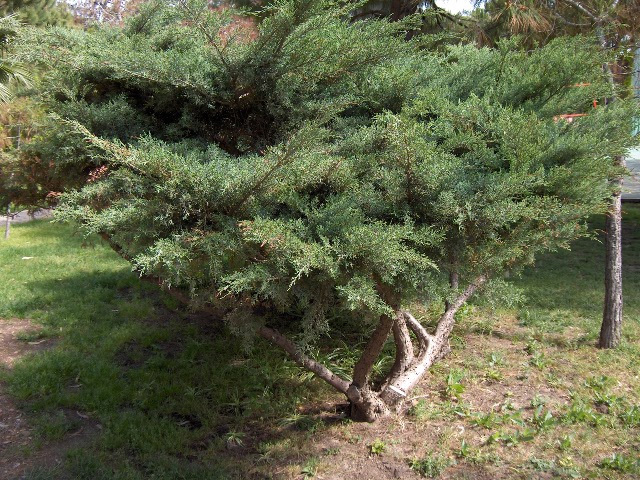Juniperus × pfitzeriana, as described in 1983 by (F. Späth) Peter A. Schmidt (born 1946) in Folia Dendrology, vol.10, is commonly known as Pfitzer juniper. It describes natural and synthetic hybrids of J. chinensis and J. sabina. The epithet honors Wilhelm Pfitzer, head propagator at Späth Nursery in Baumschulenweg, Germany (literally "nursery way;" now part of the Treptow-Köpenick district) in southeastern Berlin.
Description. Pfitzer juniper is a shrubby, evergreen coniferous hybrid tree that grows to mature heights of 10 feet (3 m) tall with a broad flat crown that grows up to 18 feet (5 m) wide.
- Branches are rising and arching in habit.
- Branchlets are coarser than those seen in J. sabina, nodding at the tips.
- Adult leaves (needles) are held in alternating pairs or trios, growing needle- or scale-like, merging smoothly into a twig without a joint. Scale-like foliage tends to predominate, with colors ranging from Blue-green, green, to yellow green.
- Pollen cones and seed cones appear on separate plants (dioecious conifers). Plants in cultivation are predominantly male.
Origin. Pfitzer juniper has a long and very interesting taxonomic history. This following account is adapted from an article written in 2000 by Mark Zampardo, in
American Nurseryman, vol.192(8):pp.32-34, and the report written in 1999 by Le Duc, et al. in
HortScience, 34th edition (6):pp.1123-1125.
- In the 1860's French missionary and botanist, Père David Armand, collected seeds from naturalized populations of J. chinensis and J. sabina in northern China.
- Armand's herbariums and notes were lost but the seeds ended up at a nursery in Metz, France under the name J. chinensis var. pendula. Male and female clones were produced from the seed and these juniper clones become popular in Europe.
- In the 1890's the Späth Nursery in Germany introduced J. chinensis 'Pfitzeriana'™, a male clone that became one of the most widely plant conifers in the world. The nursery's propagator, Wilhelm Pfitzer, planted the new clone in the nursery's display arboretum, where it remains today.
- Peter van Melle, a New York plantsman, studied living and preserved specimens of J. chinensis 'Pfitzeriana'™ and in 1947 reported his conclusion that it was of hybrid origin, i.e., J. chinensis × J. sabina. He proposed the name J. × media for this purported hybrid. The designation J. × media gained acceptance in many, but not all, important horticultural references.
- However, many years later the Royal Horticultural Society discovered that in 1938, Russian plantsman, V. D. Dmitriev, used the specific epithet, × media, for a hybrid of J. semiglobosa and J. pseudosabina var. turkestanica. Under international nomenclature regulations priority usually holds sway, hence van Melle's name J. × media was rendered illegitimate.
- The hybrid was given the name Juniperus ×pfitzeriana and the shrub in the Späth Nursery arboretum was designated Juniperus × pfitzeriana 'Wilhelm Pfitzer.'™
- In 1999, Le Duc, Adams, and Zhong published a study in which they analyzed the DNA of the Pfitzer juniper, related selections, and the purported parents of the hybrid (J. chinensis and J. sabina). Their data support van Melle's conclusion that the Pfitzer juniper is separate from J. chinensis, but rather it is a hybrid of J. chinensis and J. sabina. And according to international regulations, the name of the hybrid is J. × pfitzeriana [Pfitzer Group]. Furthermore, their results indicate that the Pfitzer Group includes the following selections; 'Fruitlandii'™, 'Gold Coast'™, 'Hetzii'™, 'Compact'™, 'Wilhelm Pfitzer'™, 'Pfitzeriana Aurea'™, and 'Pfitzeriana Glauca'™. It is likely that other cultivars will be added to the Pfitzer Group as further DNA analyses are performed.
